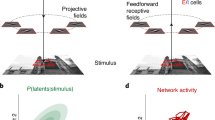Abstract
We study the improvement in timing accuracy in a neural system having n identical input neurons projecting to one target neuron. The n input neurons receive the same stimulus but fire at stochastic times selected from one of four specified probability densities, f, each with standard deviation 1.0 msec. The target cell fires if and when it receives m inputs within a time window of ∈ msec. Let σ n,m,∈ denote the standard deviation of the time of firing of the target neuron (i.e. the standard deviation of the target neuron's latency relative to the arrival time of the stimulus). Mathematical analysis shows that σ n,m,∈ is a very complicated function of n, m, and ∈. Typically, σ n,m,∈ is a non-monotone function of m and ∈ and the improvement of timing accuracy is highly dependent of the shape of the probability density for the time of firing of the input neurons. For appropriate choices of m, ∈, and f, the standard deviation σ n,m,∈ may be as low as \(\frac{1}{n}\). Thus, depending on these variables, remarkable improvements in timing accuracy of such a stochastic system may occur.
Similar content being viewed by others
References
Abeles M(1991) Corticonics: Neural Circuits of the Cerebral Cortex. Cambridge University Press, Cambridge, UK.
Agmon-Snir H, Carr CE, Rinzel J (1998) The role of dendrites in auditory coincidence detection. Nature 393: 268–272.
Arnold B, Balakrishnan N, Nagaraja H (1993) A First Course in Order Statistics. John Wiley & Sons, New York.
Balakrishnan N, Rao C (1998a) Handbook of Statistics 16, Order Statistics: Theory and Methods. Elsevier Press, New York.
Balakrishnan N, Rao C (1998b) Handbook of Statistics 17, Order Statistics: Applications. Elsevier Press, New York.
Cai Y, McGee J, Walsh EJ (2000) Contributions of ion conductances to the onset responses of octopus cells in the ventral cochlear nucleus: Simulation result. J. Neurophysiol. 83: 301–314.
Colburn HS, Han Y, Culotta CP (1990) Coincidence model of MSO responses. Hear. Res. 49: 335–346.
Covey E, Casseday JH (1991) The monaural nuclei of the lateral lemniscus of an echolocating bat: Parallel pathways for analyzing temporal features of sound. J. Neurosci. 11: 3456–3470.
Covey E, Casseday JH (1995) The lower brainstem auditory pathways. In: A. Popper, R. Fay, eds., Hearing by Bats. Springer-Verlag, New York. pp. 235–295.
Diesmann M, Gewaltig M-O, Aertsen Ad (1999) Stable propagation of synchronous spiking in cortical neural networks. Nature 402: 529–533.
Diesmann M, Gewaltig M-O, Rotter S, Aertsen Ad (2001) State space analysis of synchronous spiking in cortical neural networks. Neurocomputing 38- 40: 565–571.
Gewaltig M-O, Diesmann M, Aertsen Ad (2001) Cortical synfireactivity: Configuration space and survival probability. Neurocomputing 38- 40: 621–626.
Heil P, Irvine DRF (1997) First-spike of auditory-nerve fibers and comparison with auditory cortex. J. Neurophysiol. 78: 2438–2454.
Irvine DRF (1986) The Auditory Brainstem. Springer-Verlag, New York.
Ivry R (1997) Cerebellar timing systems. Internat. Rev. Neurobiol. 41: 555–573.
Jeffress LA (1948) A place theory of sound localization. J. Comp. Psychol. 41: 35–39.
Klug A, Kahn A, Burger RM, Bauer EE, Hurley LM, Yang L, Grothe B, Halvorsen MB, Park TJ (2000) Latency as a function of intensity in auditory neurons: Influences of central processing. Hearing Res. 148: 107–123.
Konig P, Engel AK, Singer W (1996) Integrator or coincidence detector? The role of the corticol neuron revisited. Trends Neurosci. 19: 130–137.
Marsalek P, Koch C, Maunsell J (1997) On the relationship between synaptic input and spike output jitter in individual neurons. PNAS 94: 735–740.
Matell MS, Meck WH (2000) Neurophysiological mechanisms of interval timing behavior. BioEssays 22: 94–103.
Mitchell C (2003) Mathematical properties of time windowing in neural systems. Duke University thesis.
Oertel D (1999) The role of timing in the brainstem nuclei of vertebrates. Annu. Rev. Physiol. 61: 497–519.
Oertel D, Bal R, Gardner S, Smith P, Joris P (2000) Detection of synchrony in the activity of auditory nerve fibers by octopus cells of the mammalian cochlear nucleus. Proc. Natl. Acad. Sci. 97: 11773–11779.
Pollak GD (1993) Some comments on the proposed perception of phase and nanosecond time disparities by echolocating bats. J. Comp. Physiol. A 172: 523–531.
Pouille F, Scanziani M (2001) Enforcement of temporal fidelity by somatic feed-forward inhibition. Science 293: 1159–1163.
Rhode W, Smith P (1986) Encoding time and intensity in the ventral cochlear nucleus of the cat. J. Neurophysiol. 56: 261–286.
Riehle A, Grun S, Diesmann M, Gewaltig M-O, Aertsen Ad (1997) Spike synchronization and rate modulation differentially involved in motor cortical function. Science 278: 1950–1953.
Segev I, London M (2000) Untangling dendrites with quantitative models. Science 290: 744–750.
Simmons JA, Ferragamo M, Moss CF, Stevenson SB, Altes RA (1990) Discrimination of jittered sonar echoes by the echolocating bat, Eptesicus fuscus: The shape of target images in echolocation. J. Comp. Physiol. A 167: 589–616.
Softky W (1994) Sub-millesecond coincidence detection in active dendritic trees. Neuroscience 58: 13–41.
Stuart G, Spruston N, Hauser S (1999) Dendrites. Oxford Univ. Press.
Young E, Robert J-M, Shofner W (1988) Regularity and latency of units in ventral cochlear nucleus: Implications for unit classification and generation of response properties. J. Neurophysiol. 60: 1–28.
Author information
Authors and Affiliations
Rights and permissions
About this article
Cite this article
Reed, M.C., Blum, J.J. & Mitchell, C.C. Precision of Neural Timing: Effects of Convergence and Time-Windowing. J Comput Neurosci 13, 35–47 (2002). https://doi.org/10.1023/A:1019692310817
Issue Date:
DOI: https://doi.org/10.1023/A:1019692310817



